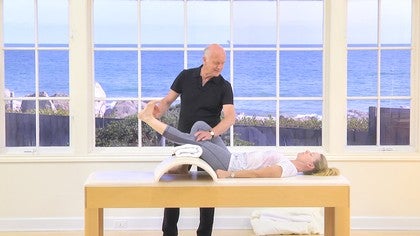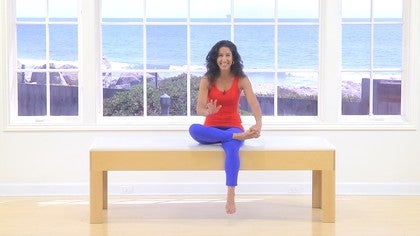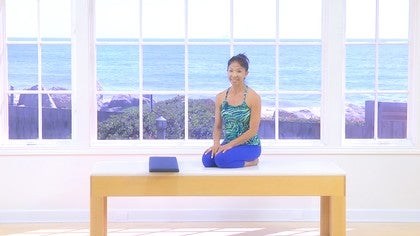Description
About This Video
Transcript
Read Full Transcript
Hi. Do you ever feel stuck in your hip flexors? Um, so much of what we do in [inaudible] is very specific, um, and very heavy inflection as are our lives, right? We spend many hours of the day sitting in chairs, driving our cars, walking forward. So we're, we're very much oriented towards moving ahead and moving into flection. So it's not a surprise that so many of us feel like we get stuck in our hip flexors. And what I mean by stuck is the feeling sometimes where you're excessively working from that part of your body when you're trying to target your abdominal muscles, for example. And other times it's not so much of an excessive heavy, muscular feeling, but rather a clicking or a popping, um, or sometimes a grinding, right? Anything that doesn't feel smooth and silence in my own body.
I love when I experience, um, not feeling the body, so to speak, but rather just kind of experiencing very free and organic movement. So I just wanted to share a couple of tips that have helped me, um, because I do get stuck very much, especially in my right hip. Um, so I'm just gonna take you guys through a couple of ideas that might help you incorporate this into Palladio's to help you change the way that you experienced some of these heavy flection exercises. So we're going to start by separating our feet just about shoulder width apart. And if you're comfortable to turn out your hips, by all means, let your hips turn out. And again, specifically what I mean is if it's standing in parallel with the second toe pointing straight ahead, makes you feel conscious or aware of your hip socket, allow the turnout to happen, respect that turnout so you feel freedom in your start position. So I'd like you to imagine that you have about a five to 10 pound weight on the top of your head and we're going to very gently project some energy out through the top of the head and place the hands on the two hip crest.
And we'll just start to glide the pelvis to one side. Circle it back as I tip my head forward over to the other side, and then forward. So what I'm thinking about is I'm doing this is that I'm moving my pelvis and my trunk on top of my very large thighbone. So we want to create as much easy circular movements in this socket, uh, to prepare for some of the Palati stuff that we're going to do. And then we'll go in both directions. And as you're doing these circles, if you do feel popping or clicking or any of that, try changing your breathing pattern and making your range of movements smaller so that your goal is to go around in the movement feeling very smooth and lots of B's feeling minimal muscle effort.
So you can just do that a couple of times in each direction and every now and then you'll continue to switch the direction that you're circling towards. It's a great way to get out of bed and start your day. So we'll do that a couple of times, again, going in opposite directions and then you'll find your center and stay there. And you could even do this in a figure eight motion. So I'm going to take my right hip forward, circling it back and around.
And then my other hip will roll forward and I'll circle that hip back and around. And if the eight idea is a little confusing, just think of a diagonal moving one hip over one pinky toe and then back around and then the other hip over the other pinky toe and back around. And again, we'll do that. Um, and we'll continue to alternate directions circling forward. And then going back, circling forward. And then going back. And as you're doing this, you're going to start to notice that there is also movement occurring at your ankles and in your feet. And you're just gonna let that happen and observe. What does it feel like, what moves more, what moves less? Does one side of your body have a tendency to create more muscle activity than the other? And you'll start to learn all kinds of stuff about yourself.
So we'll smooth out our hips that way. And then you can either sit on the floor or on a chair, um, if you don't have one of these beautiful mats at home. And a big part of the reason why we also get stuck in our hip flexors, in our modern day life is because we're always in shoes. Um, so if, if you live in shoes and if you're in a city and you work in an office and you live in leather shoes that don't really allow your toes to spread and your feet to feel supple, uh, where you're really propelling yourself off your big toe. My personally, I think that you really can't do that with any type of shoe on maybe the toe shoes these days. But the best thing is really to be barefoot as often as you can.
So a great way to get your toes to start moving around is to use your hands, spread your toes and you interlace your fingers with your toes. And at first the toes are very resilient and they are not happy about this. So at first you're just going to try and get web to web. And I say try because it's a, it's not that easy. I've been doing it for a very long time, making it look a little easier than it is. Um, if it's painful, just breathe into it.
Go very slowly and then gently remove one finger at a time because you don't want to freak out your nervous system if this is very new, different information. Once you get comfortable with that Web to web idea and really spreading all your toes around, you can keep them in there and then start to pull your foot and ankle back and circle it around. This way as what we're after is creating as much mobility in our foot. The foot is an amazing design. It blows my mind every time I take any workshop on the feet, just how pliable they are and yet how sturdy and strong they can be also to propel us forward. Um, and through life, right?
So again, you can draw these circles in both directions and continue to change it up as you go through it. Just simply noticing if there's repetitive clicking and clacking in a certain part of the movement, you're going to change your breathing pattern and also move less until you find the range that feels smooth and easy. And then again, if you're doing that for a little while, slowly remove your hand so that your foot doesn't freak out and want to recoil and get very tight again. And then you can, before you do the other side, take a minute and just notice the sensation, the difference between one foot and the other. One foot is going to feel lighter and bigger and just kind of flowy as I say, and the other foot is going to feel jealous. So you'll experience that difference. Um, so we talked about the hips and the feet and then bringing it just into the [inaudible] realm a little more specifically when we're doing things like assisted roll up or roll down. Um, for example, when you're doing your, your roll ups, the series of five of Femur Arcs, dead bugs, all of that movement at the hip, if you know that about yourself, that you tend to get stuck. And what I mean by stuck again is that you feel excessive work in that area or there's a sound or grinding texture to it. Um, it's really helpful to sit tall. Again, that idea of stacking the spine as best as you can.
And if sitting tall here makes your hip flexors talk to you, let your thighs turn out again and just ease off of it a little bit. So often I hear students say that they feel it but they can tolerate it and that makes me think that I'd like to teach them how to listen to that inner dialogue a little better. Um, because the idea is not that we're going to get really good at having a high pain tolerance. The idea is that we're going to get really good at listening to the body and then making appropriate choices so that we don't feel the body right. I don't want to know that I have a body. I just want to feel free and, and live my life and flies much right? As close as we can get to levitating the better. So we started off tall.
Whatever your tall, comfortable position is for your hips, and as you roll back, think about rolling your pelvis away from your thighs. Now and in the [inaudible] environment with the apparatus, we have springs that help us slow down the movement, right? If I had springs here and I'm rolling back there helping me decelerate, so what they're teaching my flexors is how to lengthen out and slow the movement down our everyday lives don't really provide those moments for us. So as much as we can get on our mat and take the time to just slow down and experience that ease of movement with gravity and the help of your arms, the less likely you're going to feel like you get stuck when you do your roll up in your other activities. I hope that this was helpful and I'll see you soon.
The Teacher's Corner: Common Aches and Pains
Comments
You need to be a subscriber to post a comment.
Please Log In or Create an Account to start your free trial.































